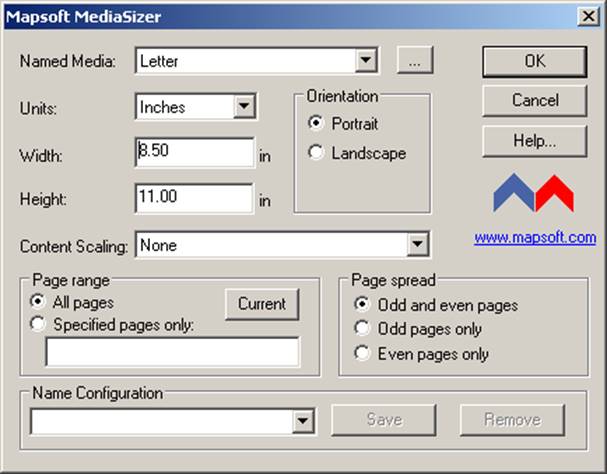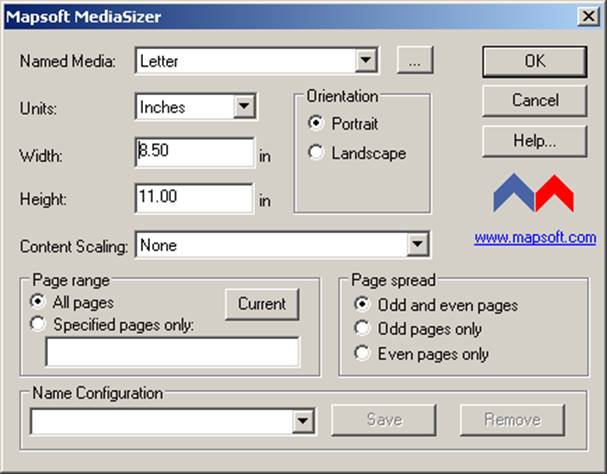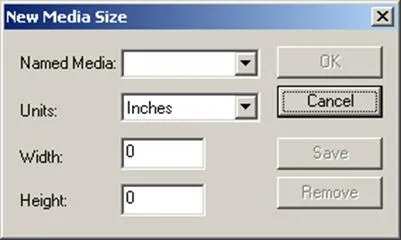Mapsoft
MediaSizer
Version 1.5
A Publishing Tool for use with Adobe Acrobat
(Version X upwards)
Running under WindowsTM Operating Systems
Issue 3
March 2021
This publication contains proprietary
information that is protected by copyright. No part of this publication may be
photocopied, reproduced or translated without the prior written consent of
Mapsoft Computer Services Limited. The information contained in this
publication is subject to change without notice. Considerable effort has been
made to ensure that this manual is free of inaccuracies or omissions, but
Mapsoft Computer Services Limited assumes no responsibility or liability for
any errors or inaccuracies that may appear herein.
Mapsoft
Computer Services Limited shall not be liable for any direct, incidental or
consequential damages of any nature, or losses or expenses resulting from the
use of this material.
Adobe and Acrobat are trademarks of Adobe Systems
Inc which may be registered in some jurisdictions.
Microsoft is a registered trademark and WindowsTM and Windows NTTM are trademarks of Microsoft Corporation.
Mapsoft is a registered trademark of Mapsoft Computer Services Limited.
Other brand or product
names are the trademarks or registered trademarks of their respective holders.
2001-2021 by mapsoft computer services limited. All
rights reserved in all countries.
15 Erme
Court
Leonards
Road
Ivybridge
Devon PL21 0SZ
United
Kingdom
Tel:
+44 (0) 2032
900473
email: support@mapsoft.com
Introduction
The MediaSizer tool allows you to
change the physical media size of a PDF document. Typically standard media
sizes (such as A4, A5 etc) are used. For example, you might want to change a
Letter size document to A4 for distribution in the European market, or an A4
sized document to Letter size for the North American market. However, this tool
will also work with non-standard (customized) media sizes.
MediaSizer works differently from the
page clipping facility in Acrobat as it allows you to specify a standard page
size, such as A4 or Letter, and unlike the Clipping facility it also allows the
page size to be increased as well as reduced. It can also be used to optionally
scale content at the same time as changing media size.
You can also combine MediaSizer with Mapsoft
ContentScaler giving you more control over the re-scaling of the contents
than you can achieve just by using MediaSizer alone. ContentScaler is available
for purchase from the Mapsoft website: mapsoft.com. Using MediaSizer and ContentScaler together you can change the media
size of a document without altering its pagination or layout. For example, you
could use the ContentScaler tool to reduce the contents of the pages within a
PDF file by 50% and then use MediaSizer to change the media size from A4 to A5
(provided the page orientation is the same for both files) all within one
automated process.
Before
you use MediaSizer it is a good idea to make a copy of the original file.
Media Sizes
Several standard
media sizes are available in MediaSizer. These include:
q Letter
q Legal
q Tabloid
q Letter-Half
q Legal-Half
q A4
q A3
q A5
q B5
q Compact
Disc
These fixed media sizes enable
configurations to be derived that are based on these dimensions. However, once
a configuration has been saved, only the final dimensions are retained, and not
the original fixed media size on which they are based.
In addition you
can also specify your own customized page sizes.
Changing the Media Size
Before you can use MediaSizer you
must first open the PDF document whose media size you want to change. You can
choose to change to/from a standard media size (such as letter or A4) or you
can define your own customized sizes. Both these procedures are described
below.
Standardized Sizes
To change the media size to a standard size:
1. Open the PDF document whose media size you want to
change.
2. Select Plug-Ins > Mapsoft > MediaSizer from
Acrobats main menu.
3. The MediaSizer dialog box now displays:

4. Select the media type from the drop-down list of standard
media sizes in the Fixed Media field.
5. Select the units for the new media from the drop down
list in the Units field.
6. Select either Preserve Left/Right Margins or Preserve
Top/Bottom Margins from the Content Scaling field if you want the
contents to be scaled at the same time as the media size is changed.
7. Now select the required Orientation of the page
(either Portrait or Landscape).
The
width and height measurements become transposed: it is important to understand
that there is no rotational element or information being created or passed into
the document.
8. Then select the required Page Spread.
9. Optionally enter a name for your media configuration
into the Name Configuration field and then click Save. This
particular media configuration will then be available for later re-use or for
use with the Mapsofts unique macro buider, Automator, which is available for
purchase from the Mapsoft website: mapsoft.com.
This plug-in allows you to use MediaSizer in batch mode across multiple files
and to use MediaSizer in conjunction with other Mapsoft publishing tools such
as ContentScaler.
10. Click the OK button to change the media size. Alternatively, click Cancel to quit the MediaSizer dialog box without changing the PDF file.
Customised Options
In addition
to changing the media size to a standard size, you can also set customised
media sizes.
To change the media size to a customised size:
1. Open the PDF document whose media size you want to change.
2. Select Plug-Ins > Mapsoft > MediaSizer from Acrobats main
menu.
3. The MediaSizer dialog box now displays:

4. Select the button in the next to the Named Media field to
display the following dialog box:

5. Type in the name of the new media type into the Named Media field,
for example Custom.
6. Select the Units of measurement to be used for the width and
height of the new media in the Units drop down list, for example Centimeters.
7. Type in the width and height measurements for the new media size into the Width and Height fields.
8. Select the Save button to save the new media type, or Cancel to return to the MediaSizer dialog box without saving this new type.
Do
not confuse this step with saving the entire MediaSizer configuration. Here you
are saving a new media type, not a new configuration.
Previously saved media types can be
removed by clicking the Remove button in this dialog box.
9. Click the OK button to return to the MediaSizer dialog box. Your
newly defined media type will now be available for selection from the Named
Media field.
Select the required Orientation,
Content Scaling, Page Range and Page Spread and save your new
configuration if required.
10. Finally,
click OK to reduce/increase the media size as desired.
Saving a MediaSizer Configuration
To save a particular MediaSizer configuration
for later re-use, simply enter a name for it into the Configuration Name field,
then click the Save button. This makes configuration available for
re-use in another session of MediaSizer. It also makes it available for use
with Automator, Mapsofts unique automation tool which allows you to work with
multiple files in batch mode.
Once saved, you can delete any existing MediaSizer
configurations you no longer require simply by selecting the appropriate one
from the drop-down list in the Configuration Name field and then
clicking the Delete button.
MediaSizer Options
The following
options are available in the MediaSizer dialog box:
Fixed Media | The media type. A drop down list of |
Units | The units in which the new media |
Height | The height of the new media. |
Width | The width of the new media. |
Content | Controls |
Orientation | Controls the orientation of the |
Page Range | Specifies |
Page | Specifies |
Name | The |
Specifying Page Ranges
When changing the media
size you can choose those pages to which this change should be applied: the
media size of the whole PDF document can be changed, or just selected pages
within that document. If you want a new media size to apply to only selected
pages choose the Specified Pages Only option from the Page Range field in the MediaSizer dialog box. You can then type the numbers of
the pages you want this media size to be applied to, into the text box at the
foot of this field.
You can apply a media
size to non-contiguous pages, and/or ranges of pages. To apply a media size to
individual non-contiguous pages type the page numbers of the relevant pages,
separating each by a comma. For example to add a graphic to pages 6, 12 and 15
type:
6, 12, 15
Any spaces are ignored,
so you can enter them or not as you prefer.
You can also specify a
range of pages to be changed to the new media size. To do this type the
starting and ending numbers in the range, separated by a hyphen. For example to
apply a new media size to pages 3 through 19 of your document type:
3-19
If you omit the first
number in the range, the first page of the document is assumed. Similarly if
you omit the last number the final page of the document is assumed. Thus if you
were to enter:
3-
the new media size
would be applied to all pages from page 3 onwards.
If you
enter:
-28
the media size would be
changed for pages 1 through 28 of your document.
You can specify both
non-contiguous pages and ranges of pages at the same time. For example to change
the media size of pages 3, 8, 9, 10, 14, and 18 type:
3, 8-10, 14,
18
Specified ranges can
overlap if you so wish. For example it is perfectly possible to enter two
overlapping ranges such as:
5-10, 7-12
Once you’ve typed in a
page range definition, if you subsequently click the All Pages button
the page range definition is retained so making it easy to go back to it should
this be required.
